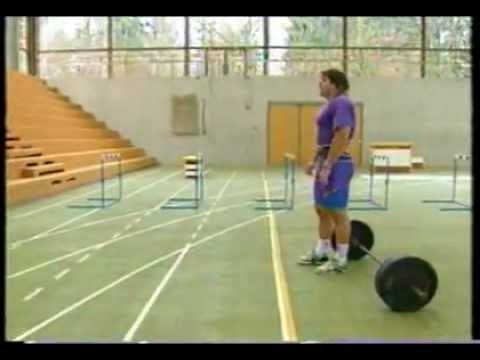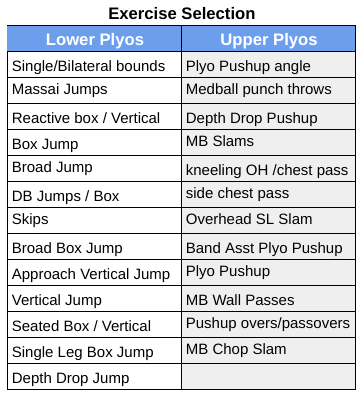Today’s workout of the week I wanted to briefly introduce plyometrics. Plyometrics can be formally defined as, “exercise involving repeated rapid stretching and contracting of muscles (as by jumping and rebounding) to increase muscle power.” They are most frequently used for sports performance and are typically neglected by normie gym-goers. However, they should have a place in most programs.
Another term often thrown out with plyometrics is "“Shock Training” or “Shock Method”. This term essentially also describes plyometrics although relying entirely on reactive movements that involve using stored energy rather than pausing in the landing. With shock training the idea is to create as much explosive force as possible by minimizing contact time and redirecting elastic energy into the subsequent concentric contraction (“upward phase”). If you wait too long upon landing then the elastic energy is lost and explosive force will decreasing, instead, you will then have to rely on starting strength to overcome inertia.
Shock Method
“An eccentric muscle action suddenly terminated in an explosive isometric contraction, thereby producing a powerful myotatic reflex, a sharp extension of the passive components of the muscle complex and a subsequent explosive concentric contraction” - Yuri Verkhoshansky
Function of Plyometrics
Plyometrics primarily fine tune the nervous system to produce force, power, and speed. They can also be used for more specific adaptations like increasing tendon stiffness. “Stiffness” always gets a bad rep, but it isn’t always bad. You want tendons to be stiff if you do activites with high force output. Think of your tendons as a basketball court. A soft tendon is a court made of sand and a stiff tendon is one made of concrete. When bouncing a basketball of sand it won’t bounce high, however, on concrete it will get significantly higher. Your tendons work similarly; with more stiffness they are better able to redirect energy. This keeps your joints and muscles safe and makes you a more explosive athlete.
Oftentimes when we compare freak athletes to general population lifters it’s obvious after doing some athletic movements (jumping, running, changing direction, etc.) which ones played sports and were exposed to plyometrics on the playing field to some degree. Stronger tendons make you springy, quick, and explosive.
Everyone can and should use plyometrics to varying degrees. If you’ve have double knee replacements maybe take it easy but there are alternatives for those folks that mimic these adaptations and provide neural benefits. You should not use plyometrics for conditioning workouts like crossfitters. You need a lot less of them than you’d think just to make progress. The point is to generate a lot of force with plyometrics; excess fatigue makes that impossible.
Westside barbell commonly recommended 40 jumps twice a week for advanced athletes and typically stick to Verkoshanky’s recommendation of 4 sets of 10 repetitions. However, if you’re newer I would stick to 20 to 30 jumps and performing sets of 3 to 5 reps with 30 to 60 seconds of rest between sets. You want good enough recovery between sets so that you 1.) don’t fail the jump and 2.) don’t significantly hamper your explosive power.
Don’t neglect depth drops for both the upper and lower body. After each jump make sure to jump down from the box instead of stepping down, this step is crucial to develop landing strength in and around the soft tissues when you eventually reach greater heights or distances in your plyometrics. As with any new training method, don’t be a jackass. Start small and milk out as much progress as possible with moderate efforts before approaching bigger levels of stress.
As a beginner, here is a lower body routine I would try for plyometrics.
Week 1 Day 1
Warmup: 3 to 5 min of low intensity aerobic work, then 3-5 min of movement prep minimum.
Every Minute on the Minute (EMOM) 5x5 Box Jump
Land each box jump, don’t step down, jump back down
Week 1 Day 2
Warmup (same as above)
Double Leg Bounds 6x4 EMOM
Week 2 Day 1
Warmup
EMOM Seated Box Jump 6x4 EMOM
Week 2 Day 2
Warmup
Double Leg Bounds 5x5 EMOM
Week 3 Day 1
Warmup
EMOM Depth Drop Box Jump 8x3 EMOM
Week 3 Day 2
Warmup
Single Leg Bounds 5x3/ea EMOM
After 3 weeks restart the wave or change up the movements. As you become more advanced you can progress the volume closer to 40 jumps per workout. Perform your strength or hypetrophy training after the jumps. I would avoid lifting to failure or performing a lot of strength work and then jumping. More fatigue will simply just dampen your ability to produce power that session. You could get away with several sets of strength work and enhance your power (post activation potentiation) however for a novice or intermmediate I would prefer they use the plyometrics as a primer for their main movement of the day.
Here are some examples of plyometrics you can perform for both the upper and lower body:
Happy jumping, ask any questions below.







